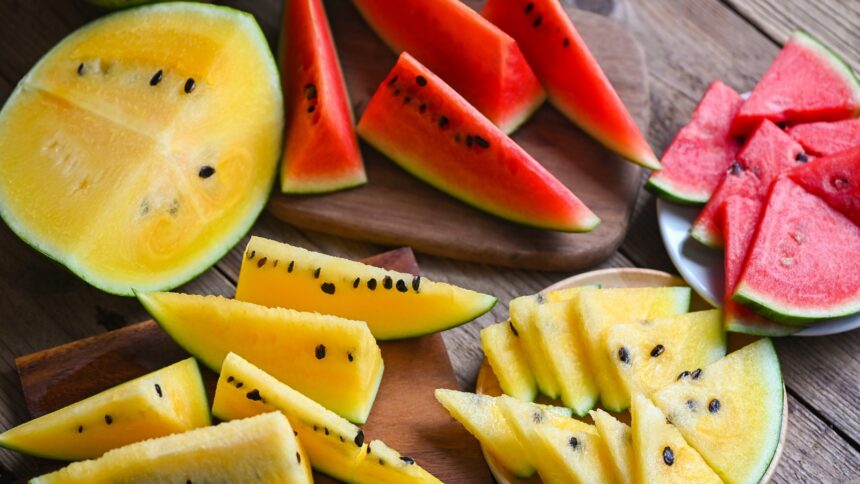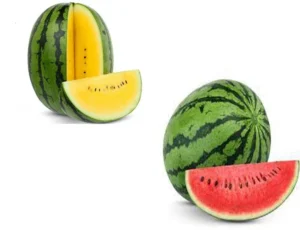The Sweet Secret of Yellow Watermelon: Nature’s Hidden Treasure
The First Bite of Something Unexpected
One hot summer afternoon, in a quiet countryside market, a curious little fruit stall stood out. Amid the usual vibrant reds and greens of fresh produce, a humble watermelon with a label that read “Golden Flesh Inside” caught my eye. Intrigued, I brought it home and sliced it open—and to my surprise, instead of the familiar red, it revealed a glowing. Sweet, juicy, and slightly honey-like in taste, this was my first encounter with yellow watermelon, and it instantly felt like discovering a secret no one had told me.
What Is Yellow Watermelon?
At first glance, a yellow watermelon looks like the regular red ones we all know and love. But slice it open, and you’re greeted by a bright yellow or golden interior that resembles sunshine in fruit form. This isn’t a product of genetic modification or artificial colouring. Yellow watermelon is entirely natural and has been around for thousands of years—predating the red-fleshed variety we’re more familiar with.
The yellow colour comes from lacking lycopene, the antioxidant that gives red watermelon its classic hue. Instead, yellow watermelon contains beta-carotene—the same compound found in carrots and sweet potatoes—which not only gives it its golden colour but also adds to its nutritional value.
A Slice of History
Watermelon has ancient roots, cultivated initially in Africa over 5,000 years ago. Back then, watermelons weren’t grown for sweetness but for their high water content, helping people survive dry climates. Interestingly, early varieties were closer in colour to yellow than red. Over time, farmers began to favour sweeter, red-fleshed melons, leading to the popular varieties we see today.
However, some communities preserved the original yellow types, passing seeds through generations. Today, the yellow watermelon is making a comeback, not just for its novelty but for its unique taste and health benefits.
Why Yellow Watermelon Tastes Different
The flavour of yellow watermelon is subtly different from its red counterpart. It’s often described as more honeyed, with hints of apricot or mango. While red watermelon offers a fresh, classic summer sweetness, yellow watermelon adds a layer of richness that’s both unexpected and delightful.
That sweetness isn’t just good for your taste buds—it reflects a higher concentration of natural sugars, making it perfect for smoothies, fruit salads, or just enjoyed as-is, chilled and sliced on a warm day.
The Golden Health Benefits
Apart from being delicious, yellow watermelon is also packed with nutrients. Here’s what makes it a healthy choice:
- Beta-carotene: This antioxidant helps support eye health, boosts the immune system, and may protect against certain cancers.
- Vitamin A & C: Essential for skin health, immunity, and tissue repair.
- Hydration: With over 90% water content, it’s excellent for staying hydrated.
- Low Calorie: Sweet but guilt-free. A cup of yellow watermelon has fewer than 50 calories.
This makes yellow watermelon an excellent choice for anyone looking to enjoy something sweet while staying on track with a healthy lifestyle.
Yellow Watermelon in the Garden
For home gardeners, growing yellow watermelons can be a rewarding experience. It requires similar conditions to red watermelon—plenty of sun, warm temperatures, and well-drained soil. Some popular yellow varieties include:
- Yellow Crimson: Looks like a traditional watermelon on the outside but is golden inside.
- Desert King: Known for its drought resistance and bright flavour.
- Yellow Doll: A smaller, early-maturing variety perfect for small gardens.
Planting yellow watermelon can bring a touch of surprise and joy to your harvest season—plus, it’s a great conversation starter when shared with friends or family.
A Cultural Comeback
In recent years, yellow watermelon has been gaining attention in farmers’ markets, food festivals, and on social media. Chefs are experimenting with it in gourmet dishes—from yellow watermelon gazpacho to vibrant fruit tarts. It’s also become popular in juice bars and health cafes, and it is loved for its colour and nutritional value.
What was once a lesser-known cousin of the red watermelon is now finding its place in the spotlight. It’s no longer just a hidden treasure—people are beginning to appreciate it for what it truly is: a naturally occurring, healthful, and flavorful delight.
A Memory Worth Repeating
That first bite of yellow watermelon stayed with me. Not just because it was new and different but because it reminded me that nature is full of surprises. Sometimes, the most delightful things are the ones we never expect. Since then, every summer, I make it a point to buy at least one yellow watermelon—not just to enjoy it but to share that little surprise with someone else.
My nephew now calls it “sunshine fruit,” and seeing his excitement as he bites into the golden flesh is the kind of memory that lasts a lifetime.
conclusion
Yellow watermelon might still be a mystery to many, but it’s a reminder that not everything good has to follow the usual path. Whether you’re looking for something new to grow, a different flavour to try, or just a healthier snack, yellow watermelon is a beautiful blend of history, taste, and nutrition.
So, the next time you pass by a farmer’s market or scroll through your local grocery delivery app, watch for this golden gem. You might just fall in love with a whole new kind of watermelon.







